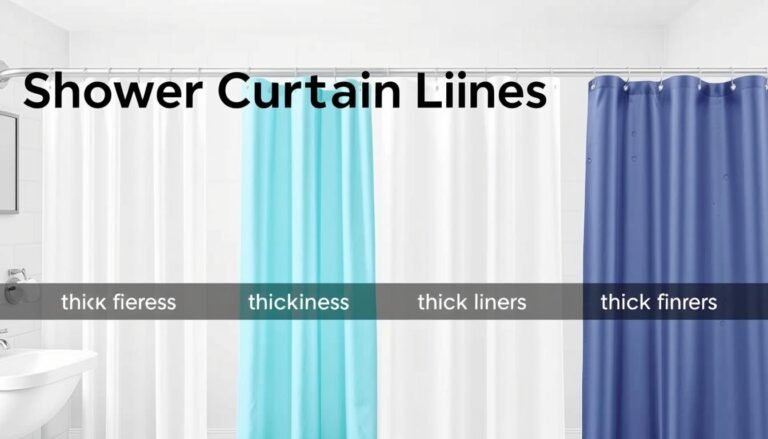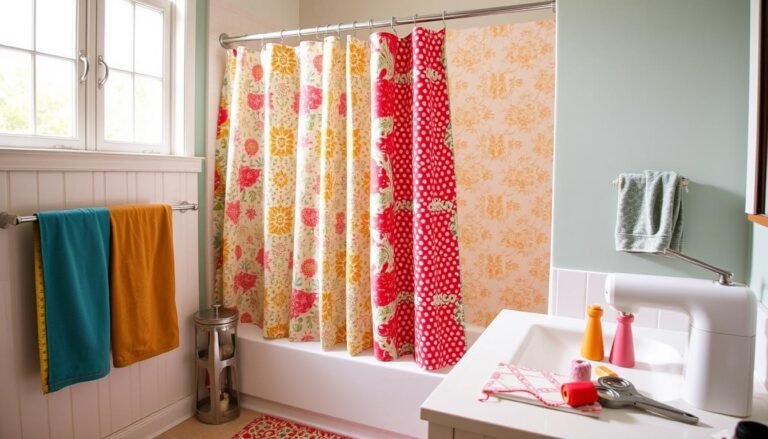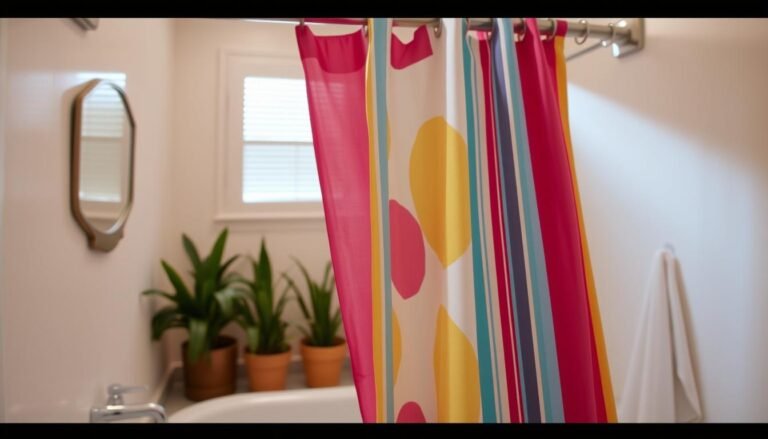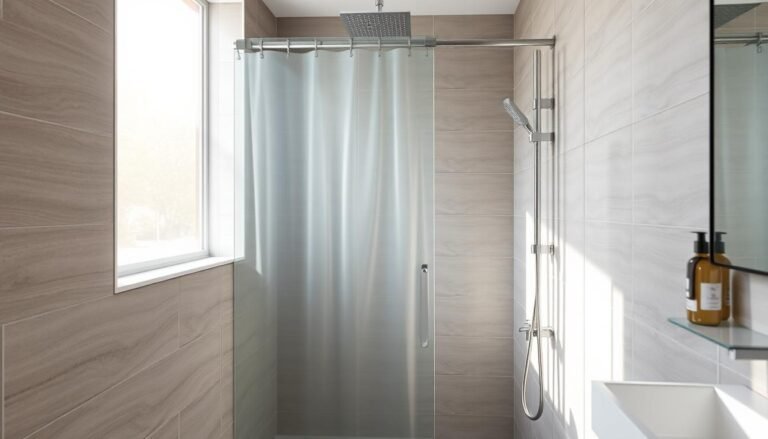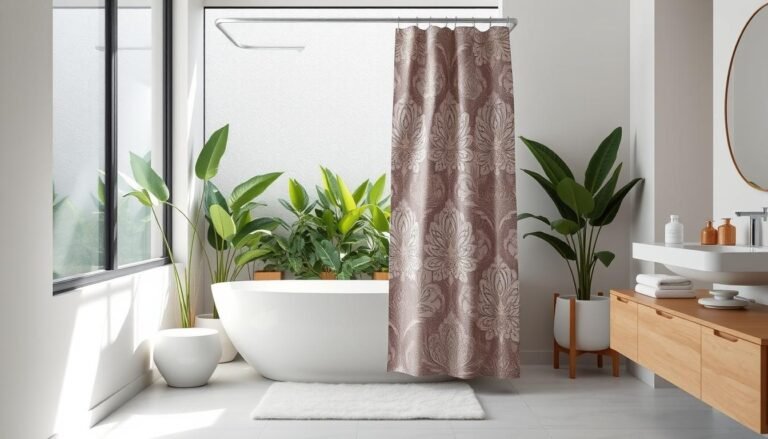Keep Your Shower Curtain Rod Up: Easy Solutions
Many homeowners struggle with shower curtain rods that keep falling. These rods are vital for a bathroom’s look and to prevent water from splashing out. But if they’re not installed right, they can lead to issues. This often happens due to not following instructions or missing important steps during installation.
In bathrooms with tile walls, rods may slip because the surface is too smooth. This issue can get worse with a heavy shower curtain. Besides, low-quality rods or those damaged by moisture can also lose their grip. We’ll explain how to pick, install, and keep your shower curtain rod in place.
For instance, adhesive tension rod holders are a great fix. They’re affordable, at just $7, and match well with white tiles. Plus, they’re designed to fit rods of different sizes, giving them a firmer grip.
Getting the installation right matters a lot. I had my shower curtain rod fall many times in months. I tried making adjustments and even positioned it differently, but nothing worked. At last, felt furniture pads and adhesive solutions did the trick. Although it’s a recent fix, it’s been effective, even getting a thumbs up from my family.
Look into various methods and products that will keep your shower curtain rod secure. This way, you’ll achieve both functionality and style in your bathroom.
Understanding Why Shower Curtain Rods Fall
Shower curtain rods often slip or fall. Understanding why this happens can help. You can make sure they stay up better.
They might fall due to incorrect installation or the wrong surface type. Not following guidelines or using the wrong tools can cause slips. On smooth surfaces, like tile, tension rods struggle because there’s not enough grip.
Common Causes of Shower Curtain Rods Falling
One common problem is slick surfaces in bathrooms. Tension rods can’t grip well on smooth, wet surfaces. This leads to them slipping often. Also, if tension rods are too tight on drywall, it can crack the wall.
The Role of Surface Material
The type of surface affects how well rods hold up. On slippery surfaces, rods fall more easily under the curtain’s weight. You could use strong glue to attach rubber lining to the rod ends for better grip. Installing closet pole holders can also stop rods from falling.
Impact of Humidity on Shower Curtain Rod Stability
Humidity plays a big role too. In moist bathrooms, some rods don’t last long. Taping the rod’s middle can be a short-term fix. But, a Rotator Rod with a No-Drill Adapter offers a longer-lasting solution without drills.
For renters, adhesive tension rod holders are affordable and easy to use. They cost about $7, stick on easily, and can be moved. They come in two sizes to fit different rods.
For more tips, check out this resource.
Choosing the Right Shower Curtain Rod
When picking a shower curtain rod, think about types and materials for your bathroom. Knowing the different options helps keep a DIY shower curtain rod stable.
Types of Shower Curtain Rods: Fixed versus Adjustable
There are fixed and adjustable shower curtain rods. Fixed rods are sturdy but need drilling, not great for renters. Adjustable rods don’t need drilling and are easy to put up. But, they might harm drywall.
Material Considerations: Stainless Steel, Electroplating, and PE
Choosing the right material is key for durability and looks. Stainless steel lasts long but costs more. Electroplated and PE rods are cheaper but might not last as long. Picking what fits your bathroom needs can avoid replacing the rod too often.
Choosing Between Straight and Curved Rods
You can pick from straight or curved rods. Straight rods are simple and straightforward to install. Curved rods give more room in the shower and can stop the curtain from clinging to you. They’re especially good for small or rectangular tubs.
Here’s a comparison to help you choose the best for your bathroom:
| Type of Rod | Installation Method | Pros | Cons |
|---|---|---|---|
| Fixed Rod | Drilling Required | Sturdy, Reliable | Permanence, Not Ideal for Renters |
| Adjustable Tension Rod | No Drilling | Easy Install, Flexible | Possible Drywall Damage |
| Stainless Steel | Varies | Highly Durable | Expensive |
| Electroplating | Varies | Cost-Effective | Less Durable |
| PE | Varies | Budget-Friendly | Shorter Lifespan |
| Straight Rod | Varies | Classic Design | Less Space |
| Curved Rod | Varies | More Space, Enhanced Design | Complex Installation |
Choosing the right rod, whether fixed or adjustable, made of stainless steel or electroplating, matters. It helps in keeping your shower curtain rod in. The correct pick adds to your bathroom’s function and style. This means less trouble with adjustments or needing new rods.
How to Make Shower Curtain Rod Stay Up
It can be hard to keep a shower curtain rod up, especially on tile or fiberglass. You need the right methods and tools to keep it stable.
Proper Installation Techniques
Knowing how to install the rod well is the first step. Always follow the instructions given by the maker and use the right tools. If you’re drilling into tiles, put masking tape on them first. This stops the drill from slipping. Also, drill through the grout seams to avoid breaking the tile.
Using Tension Rods for a Drill-Free Solution
Using tension rods is a good way to avoid drilling. These rods work by pressing between the walls of the bathroom. This is great for places you’re renting where drilling’s not allowed. But, tension rods might not stay up well on tile or fiberglass. To fix this, try putting rubber shelf liner material under them. Or, use a No-Drill Adapter with a Rotating Curved Shower Rod for better grip. Check out this recommendation for more tips on how to secure shower curtain rods.
Adhesive Solutions for Extra Hold
For more hold, using adhesives can help a lot. Adhesive holders are great because they stick well to white tiles and are clear. They have a lip to stop the rod from dropping if it gets loose. You just peel and stick them where the rod goes. They also come in many sizes to fit your rod perfectly. This means you can move them without messing up the stickiness. So, your shower curtain rod will stay up even with lots of use.
Every one of these methods offers a custom way to keep your shower curtain rod secure. This way, it can handle daily use while keeping your curtain in place.
DIY Solutions to Secure Your Shower Curtain Rod
Preventing your shower curtain rod from falling can be easy with the right methods. You can use several creative methods to make your shower curtain rod more stable.
Creating More Friction with Rubber Shelf Lining Material
Using rubber shelf lining is a good way to stop your shower curtain rod from slipping. Cut small pieces and put them at the rod’s ends. The rubber’s extra grip will keep the rod firm on smooth surfaces, making it more stable.
Using Closet Pole Holders on Drywall
If you have drywall in your bathroom, try using closet pole holders. They support the rod well without needing too much tension. Just screw the holders into the drywall at the right height and make sure they’re level. Then, put the shower rod in. This solution keeps the rod steady and makes adjustments easy.
Securing the Rod Middle with Duct Tape
Duct tape can be a great temporary fix. Wrap some duct tape around the rod’s middle to keep it from moving. This easy fix uses things you already have at home. Having duct tape nearby can be very useful for quick repairs.
Find more shower curtain rod tips and learn other ways to improve your bathroom. These DIY methods are easy, effective, and can save you money.

Hey there, I’m Alex Hanson and I’m passionate about all things covers! Whether you’re looking for a car seat cover to protect your vehicle or an oven cover to keep your kitchen clean, I’m here to help. With years of experience in the industry, I have plenty of knowledge and insights to share with my readers. So, if you care about protecting your belongings and making them look their best, you’re encouraged to read my blog as I explore the perfect cover for every need.


